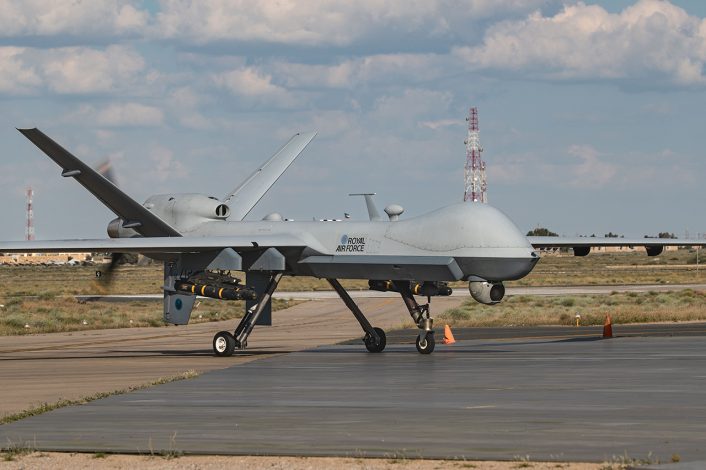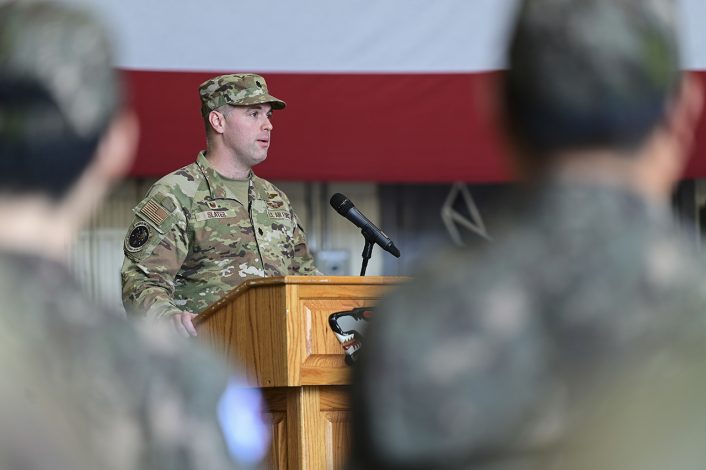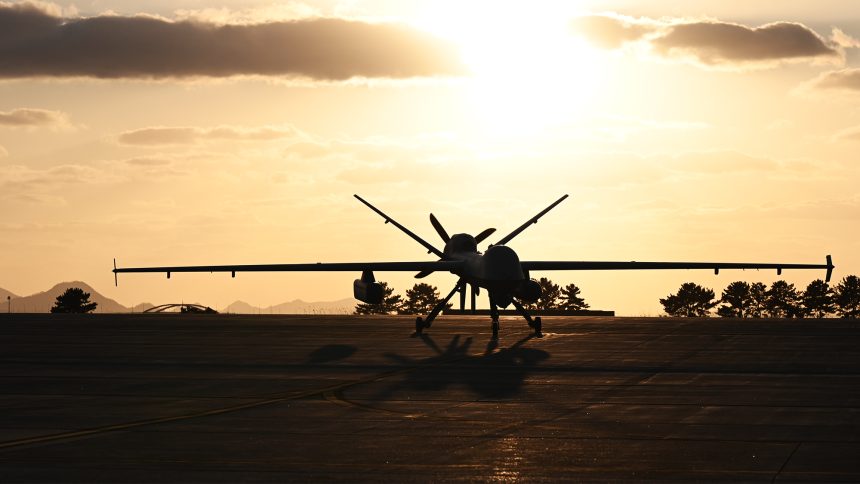The 431st Expeditionary Reconnaissance Squadron was activated for the first time since WW2 at Kunsan Air Base, South Korea, to operate MQ-9A Reaper unmanned aerial vehicles.
82 years after it was first formed, a ceremony held on Sept. 28, 2025 saw the 431st Expeditionary Squadron reactivated into the U.S. Air Force. A tenant unit of Kunsan Air Base’s 8th Fighter Wing, which already boasts two squadrons of F-16s, the 431st ERS will become the first unit permanently based in South Korea to operate the MQ-9 Reaper.
Though mostly known for its strike capability, the deployment of the MQ-9 Reaper to South Korea brings a potent intelligence, surveillance, and reconnaissance capability. Alongside the Reaper’s integrated electro-optical/infrared camera turret and AN/APY-8 Lynx multi-mode radar, a wide array of additional sensor payloads can be fitted with conformal mounts or as podded units. Details are only available for a small number of these payloads, with new undisclosed types being identified on a regular basis.

In combination with the Reaper’s exceptional endurance – stretching to over 24 hours continuously airborne without a full weapon load – these sensors allow an extremely persistent ISR presence to be maintained over areas of interest. For Kunsan’s Reapers, this capability will clearly be concentrated on the border between South Korea – officially the Republic of Korea – and North Korea, or the Democratic People’s Republic of Korea. Dividing the Korean peninsula in two, the 160 mile long land border is bound on both sides by the Korean Demilitarized Zone.
No military activity is officially permitted in this zone, aside from the guards posted to the Joint Security Area (JSA) where the two nations can engage in cross-border talks, but ISR aircraft flying just outside of this buffer zone are easily able to collect intelligence of various types from the other side. U.S. and South Korean military aircraft are a near constant presence in these skies, with aircraft types involved including U.S. RC-135W/V Rivet Joints and P-8A Poseidons, and South Korean E-7A Peace Eyes and RQ-4B Global Hawks. U.S. Army RC-12 Guardrail turboprop aircraft were also a regular sight in the area up until their withdrawal at the end of July 2025. The introduction of MQ-9 Reapers will almost certainly help to chase up any shortfall left by the Guardrail’s retirement.
Republic of Korea RQ-4B Global Hawk
Republic of Korea E-7 Peace Eye
US Air Force RC-135V Rivet Joint
A good amount of ISR over South Korea today pic.twitter.com/02WLYdowaO
— Zaes (@ZaesADSB) March 4, 2024
Captain Ryan Jayawardena, Director of Operations for the 431st ERS, said “It’s an honor to write the next chapter, side by side with our Korean allies. Activating the 431st reflects our shared commitment, hard work, and the strength of an alliance ready for today’s challenges.”

The first commanding officer of the reactivated squadron is Lieutenant Colonel Douglas J. Slater. “Deploying the MQ-9 brings a powerful capability to the region,” commented the Lt Col. “We’re here to support the mission, deepen cooperation, and demonstrate our shared commitment to maintaining security and stability across the Indo-Pacific.”
Kunsan previously supported temporary MQ-9 Reaper operations during Exercise Freedom Flag 24-1, held in the latter half of 2024.
Maintenance personnel standby before a US Air Force MQ-9 Reaper takes off in support of Freedom Flag 24-1 at Kunsan Air Base in South Korea on Oct. 30.
Freedom Flag 24-1 is a large-scale tactical air force exercise between US and allied partners. pic.twitter.com/M3i5v1rcz6
— Ryan Chan 陳家翹 (@ryankakiuchan) November 1, 2024
History of the 431st
The 431st was first activated in 1943 as the 431st Fighter Squadron, operating Lockheed P-38J Lightnings in a long-range bomber escort role from Australia. The squadron relocated several times during the Second World War as frontlines shifted, and eventually following the surrender of Japanese forces the squadron moved to Seoul, South Korea, now operating P-51 Mustangs. In 1949, the squadron began its first period of inactivity after several years assigned to bases in Japan. Moving to the United States, the 431st was reactivated in 1952 as an air defence fighter squadron equipped with F-86 Sabres.
P-38 “Pudgy V” of the US 431st Fighter Squadron at Dulag airfield on Leyte Island, Philippines, 1944. #WW2 pic.twitter.com/65qKpOsQBy
— WWII Pictures (@WWIIpix) March 30, 2020
From the mid to late 1950s, the squadron operated over Europe and North Africa. Moving back to North America in the mid 1960s, the squadron traded in its F-102 Delta Daggers for the new F-4C, and then F-4D Phantom II. The squadron’s primary role during this time was training pilots for onward deployment to overseas theatres, as well as foreign pilots from the many air forces who had chosen to procure the Phantom II.
The unit’s next, and last manned, aircraft upgrade was to the F-111 Aardvark, which it flew from McClellan Air Force Base, California. This time the 431st was a Test & Evaluation squadron, operating in this role for 12 years until it was wound up in 1992.









